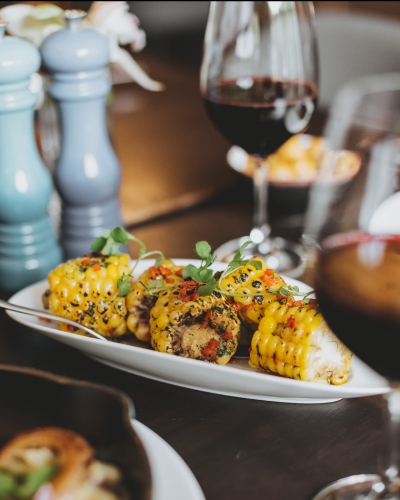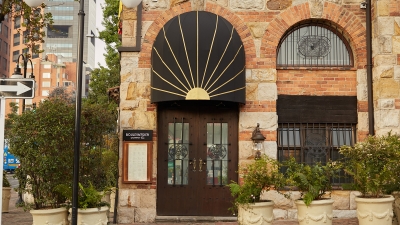An abundance of foods coming from tropical lands and the creativity to use them are common traits to the cuisines of different regions of Colombia. The beautiful majesty of The Andes mountains, thousands of kilometres along the deep and wild Pacific coast, or the great Caribbean, unanimous in its joy and warmth, delineate cultural values deeply tied with foodways. They include key pre-hispanic ingredients such as corn, sacred for representing the majesty of the earth, or daily culinary rituals around cacao - a native crop - and coffee, adopted as local after it travelled centuries ago from Ethiopia through Europe. Or ají (chili) that although not the protagonist, has always been present and in many cases the only condiment long before salt. A peasant lifestyle characterizes Andean cuisines, which are enriched by deep Afro flavours predominant in both Colombian coasts that in turn contrast with the rustic nature of the flatlands on the east side of the country. Fruits of every shape and colour are wherever you look, and wild plants and animals fill up the Amazon Forest.
Unity unfolds in common dishes even if their versions are in the hundreds: tamales (a dense meat or fish stew wrapped in plantain or palm leaves, or corn husks); envueltos (a sweet or sour corn dough wrapped in leaves or husks, and steamed); and arepas, a native bread made out of corn, cassava or wheat that can be puffy, dense, or flat, and grilled, deep fried, or pan-seared, eaten by itself or with butter and salt, or cheese on top. Stuffed too. They are often served with the Colombian mother sauce called hogao or refrito: a sauteed mix of tomatoes, onion, garlic and aromatic herbs.
Diversity blooms in the numerous versions of these common culinary themes that really take on their own life depending on regional specificity. Here, Four Seasons Hotel Bogota and Four Seasons Hotel Casa Medina Bogota present just a few examples of a regional culinary landscape hard to contain in a few recipes, but representative of its deliciousness.
The Northwest
Parva is huge in Antioquia and some other areas of the Coffee region: sweet and salty bready snacks made with cassava, corn or wheat flour, and fried or baked, such as pandeyucas, pandebonos, buñuelos, arepas de tela, bola, mote, and choclo, usually served with quesito (fresh semi-soft and fatty cheese) or cuajada (curdled cheese); chorizos and tamales, mondongo (a thick soup with tripe, pork, chorizo, vegetables, root vegetables, and seasonings); and beans served with white rice, patacones (flattened fried green and sweet plantains), ground beef, chorizo, pig skin and guacamole.
The Caribbean
Sancocho, a meat and root-based stew that has hundreds of versions across the country, finds one of the most representative ones in the Caribbean fish sancocho, or one with three different kinds of meat (called trifásico). And the one with meat cured in salt from La Guajira peninsula. Rice with shrimp is also a favourite in this area, fried fresh fish served with patacones, coconut rice and a fresh salad. And two of the most special side dishes from this region: boronía (eggplant puree mixed with ripe plantains and seasonings) and carimañolas (a cassava dough stuffed with cheese or meat and fried).
The Central Area
Ajiaco, probably the most recognizable Colombian dish apart from arepas, is very popular in the central high plateau and more specifically in the capital city. It is a soup made with three different kinds of potatoes, aromatized with guasca (gallant soldier), and served with pieces of boiled corn on the cob, rice, fresh avocado, pickled capers, and heavy cream. Fruits such as feijoa (pineapple guava), guanábana (soursop), maracuyá (passionfruit), curuba (banana passionfruit), lulo, and cactus tuna, are consumed en masse in juices, preserves, candies, mousses, and custards.
The Pacific Coast
Encocao, a rich fish or seafood stew cooked in coconut and aromatized with hierbas de azotea - fragrant and potent aromatic herbs grown in elevated canoes or bins to protect them from animals and inclement weather - is a symbol of the deep and wild flavours or this region. So is costeño cheese (a salty hard or semi hard version of a peasant cheese) and a tamal made with rice, meats and veggies, well seasoned, called pastel de arroz. Cucas (wheat flour and cane sugar paste cookies); and cocadas (shredded coconut and cane sugar paste candy), almost a staple in this region as well as in the Caribbean coast.
The Eastern Flatlands and The Amazon
Food at Llanos Orientales is hearty. Rice arepas and rice bread, cassava cakes, mamona (an entire veal roasted over an open fire), hallacas (a version of tamales shared with neighbouring nation Venezuela); and queso de mano (string fatty cheese dough made by hand). Indigenous knowledge and culinary practices are especially important in the Amazon forest: tucupí (fermented wild cassava mixed with chiles, ants, and seasonings) is a basic product in paste or as a sauce; casabe (a native bread made with coarse toasted cassava flour), fariña (toasted cassava flour), pescado moqueado (a fish that is wrapped in plantain leaves, buried, and slow cooked with the heat transferred from a campfire), insects, and marmalades made with Amazonian fruits.
Four Seasons Bogotá and Casa Medina are more than proud to have on their menus some of these items: pandeyucas, almojábanas, iconic arepa de huevo, an egg-filled fried kind from the Caribbean - not to be missed - fruit samplers, cuts of meat, and stews. It’s just a taste of Colombian biodiversity and of the spirit of the people cooking and serving this culinary heritage. The journey is long and fascinating.















